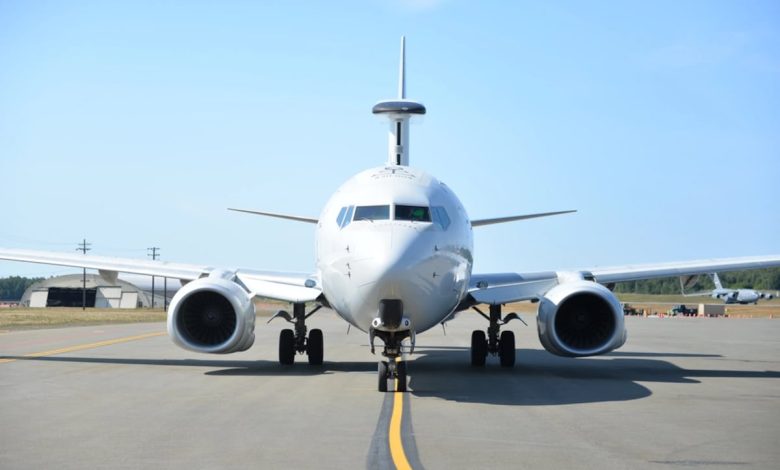Defense officials advocate for diverse target-tracking architecture

Amid reports that the White House may scrap the Air Force’s plans to replace its fleet of air moving target indicator aircraft, defense officials in recent weeks have emphasized the key role the platform plays in the Defense Department’s broader target-tracking architecture.
The Pentagon in recent years has been exploring options for shifting some moving target indicator, or MTI, missions traditionally performed by aircraft to satellites. The Space Force and the National Reconnaissance Office have been leading studies and launching prototypes to consider the viability and value of space-based options.
As those demonstrations get off the ground, the Air Force is on a parallel path to replace the aircraft currently used to track air-moving targets — its aging E-3 Airborne Warning and Control System — with the more capable, Boeing-built E-7 Wedgetail. The E-7 has been viewed as a near-term bridge to whatever future architecture the department develops, and the service’s plan is to buy the first two Wedgetail prototypes as soon as 2028.
But as the White House and the Pentagon finalize a budget plan for fiscal 2026, President Donald Trump’s administration is reportedly considering canceling the E-7 buy, according to Aviation Week.
The Air Force wouldn’t confirm the report, but a spokesperson told Defense News the service is “continuing to work with OSD on the E-7A Wedgetail program throughout the development of the FY26 budget request.”
In recent testimony and at events through the Washington, D.C., region, defense officials have emphasized the importance of an air moving target indicator capability that includes both air and space assets — especially as Space Force and NRO analysis is ongoing.
Lt. Gen. Shawn Bratton, deputy chief of space operations for strategy, plans, programs and requirements, said Thursday that while the space-based demonstrations haven’t yet delivered clear data to inform program decisions, early indicators support a mixed architecture.
“We think there are kind of synergies of having both flavors of this capability right now, but we’re really waiting for some just hard engineering data to understand what we can see from space, and how good is that going to be,” Bratton said during a virtual Mitchell Institute event.
Air Force Chief of Staff Gen. David Allvin told House appropriators May 6 that while satellites can provide key sensing capabilities, they’re not ready to take over the full AMTI mission. As a result, aircraft like the E-7 Wedgetail and E-3 Airborne Warning and Control System are still needed.
In a May 13 hearing, U.S. Northern Command Commander Gen. Gregory Guillot told the Senate Armed Services Committee the department needs a layered approach to tracking advanced threats that includes everything from undersea sensors to detect enemy submarines, standoff weapons, aircraft and satellites.
“I think it’s a seabed-to-space approach,” Guillot said.
Tracking ground and air moving targets will play a key role in what Guillot called the “domain awareness layer” of a future Golden Dome capability — an advanced missile defense and defeat architecture championed by Trump.
The Space Force and the National Reconnaissance Office have been working closely on the MTI studies and have been largely tight-lipped about what satellites and other prototypes have been launched to demonstrate the space-based capability.
NRO director Chris Scolese has acknowledged in the past that his agency launched some GMTI prototype satellites, and Guillot noted in the hearing this week there are “a number of” AMTI prototypes on orbit today. The service expects to have an operational space-based MTI capability by the early 2030s.
Bratton declined to offer more details on the AMTI demonstrations but said the results of all of the analysis will help answer key questions like, “How good is this capability from space?” and “How is it compatible with existing AMTI capabilities that the Navy and the Air Force fly?”
Former Air Force Secretary Frank Kendall told Defense News there are looming technical challenges surrounding the switch to satellites for MTI missions. Those include questions around power systems and whether a satellite sensor can penetrate cloud cover, he said. The satellites would also need to be more survivable and able to withstand an attack.
A fully space-based MTI architecture is likely years away, Kendall said, and those systems would not be ready in time to retire the E-3 without risking a capability gap.
“We’re trying to get a lot of that functionality into space, but that’s going to take a while, and there’s some technical challenges with that,” Kendall said, adding that the Wedgetail has been a crucial component of the Air Force’s near-term planning.
“There’s a pretty high sense of urgency about getting [the E-7] fielded,” he said.
Courtney Albon is C4ISRNET’s space and emerging technology reporter. She has covered the U.S. military since 2012, with a focus on the Air Force and Space Force. She has reported on some of the Defense Department’s most significant acquisition, budget and policy challenges.
Stephen Losey is the air warfare reporter for Defense News. He previously covered leadership and personnel issues at Air Force Times, and the Pentagon, special operations and air warfare at Military.com. He has traveled to the Middle East to cover U.S. Air Force operations.







